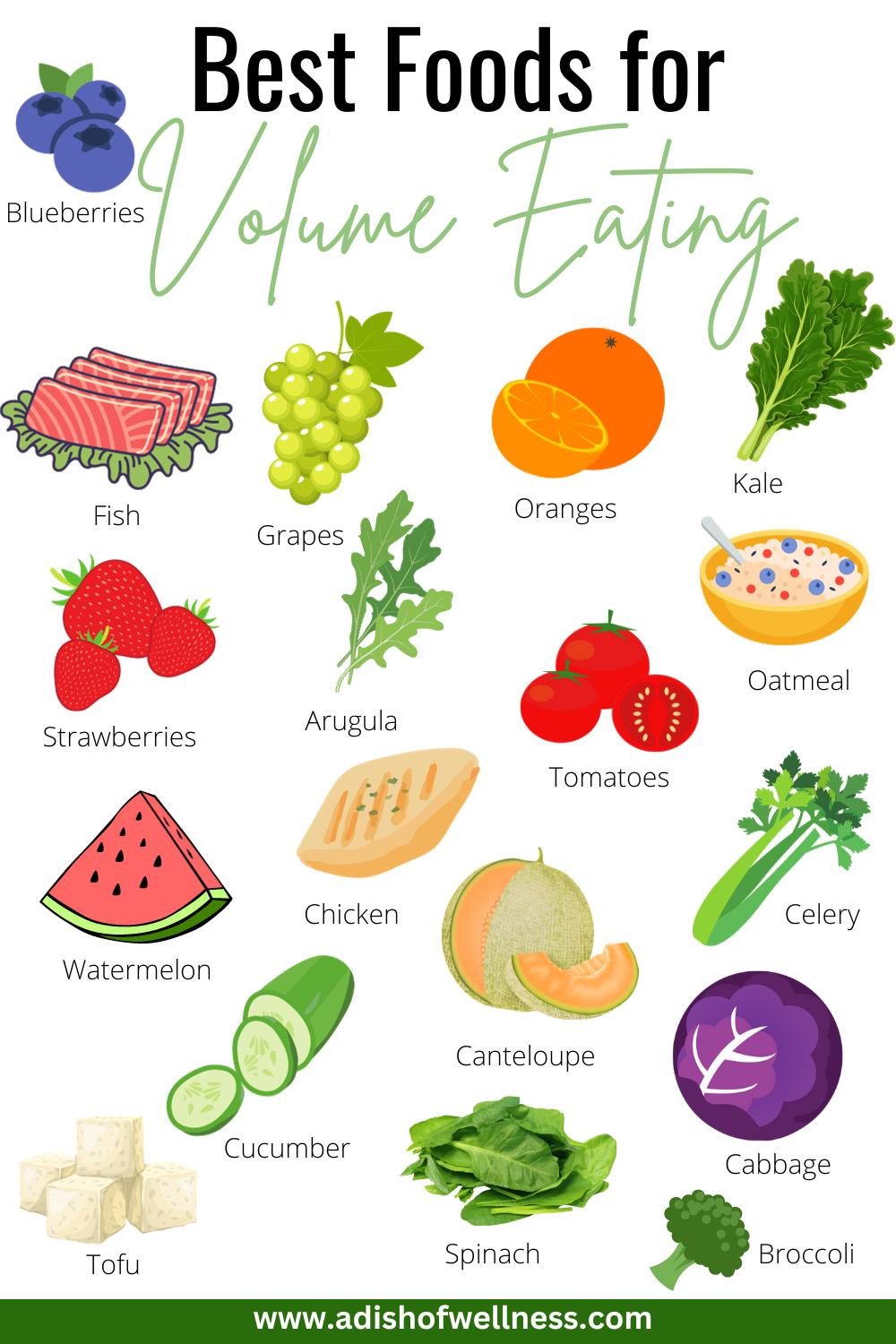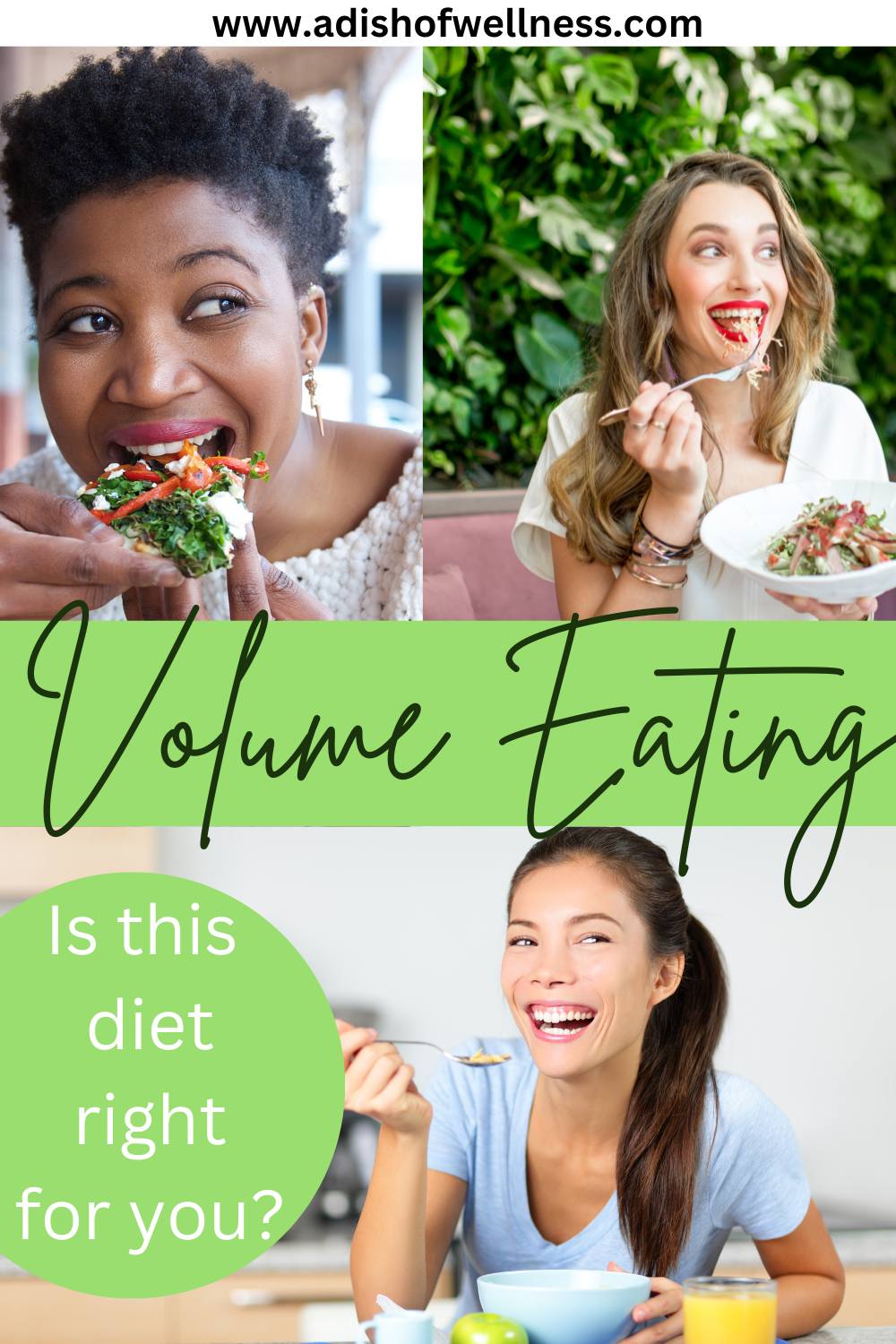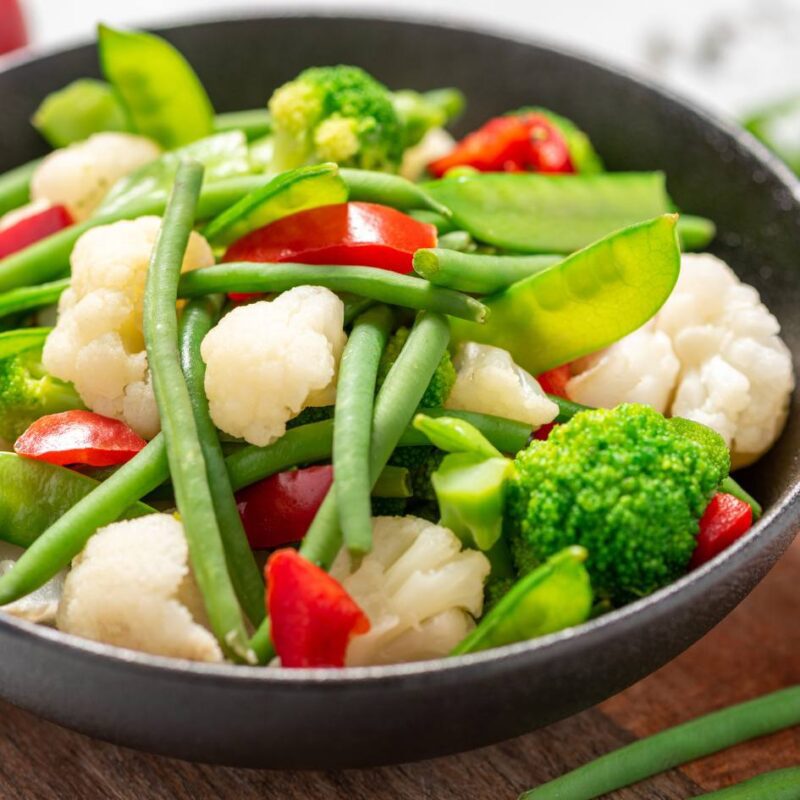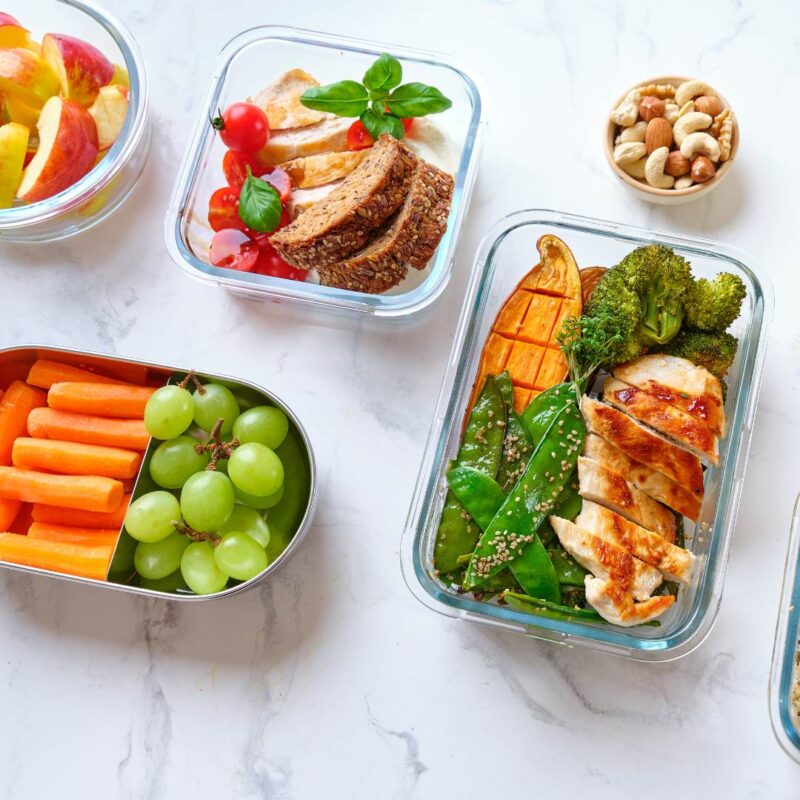
This post may contain affiliate links. Disclosure here.
Volume Eating is a dieting strategy whereby you fill up on large portions of nutrient dense foods that are minimal in calories. The high volume of low caloric foods takes longer to eat, gives the appearance of a large plate of food, keeps you satiated, and provides you with the feeling that you are not being deprived.
With this method, you are not constantly thinking about food like you may with some diets, rather it works on the philosophy of eating more versus eating less. Read more to discover about Volume Eating, how it works, and if it is right for you.
How Does Volume Eating Work?
Volume Eating is a strategy to maximize the amount of food you can eat while simultaneously keeping your calorie intake as low as possible. It allows you to eat larger portions of low caloric foods that take longer to eat, which allows time for your brain to get the signal that you are satiated.
The macronutrients within food provide different amounts of calories per gram. 1 gram of fat is 9 calories, while 1 gram of protein and 1 gram of carbohydrate is only 4 calories.
In this plan of Volume Eating, one would try to consume foods that are lower in calories. Instead of a high fat meal that contains more calories, one would choose foods that contain plenty of water and fibre pairing with a lean protein.
This strategy works on the fact that calories and physical food amount are not directly correlated. A higher volume of food does not always mean more calories; it all depends on what you are creating the volume with on your plate. Is it a big pile of mashed potatoes?
Or is it a huge salad full of vegetables? When Volume Eating, one needs to be mindful of volume and nutrient value. Eating a large bowl of diet jello may be low in calories, but is also void of nutrients.
The Volume Eating method also works on the fact that the human stomach can only hold a certain amount of food at any one time. So if you fill up on high volume nutrient dense foods, you will feel full and have less space for higher caloric foods and not have those cravings or feelings of deprivation. Your brain will get the signal from the stomach that you are satiated.
According to this article in Precision Nutrition, our appetite is based on how much total food volume passes through our digestive tract. If a lot of food volume passes through, we’re satisfied.
If very little passes through, we’re hungry. Therefore, the volume of foods may keep us fuller and more satiated longer during the day.

How Do You Determine High Volume Food?
Save this pin for reference.

High volume food has a high water and high fibre content with a low sugar and fat content, keeping calories low. Low volume foods are high in fat or concentrated sugars. Low volume foods are not necessarily unhealthy, they are just more caloric.
For example, an avocado is extremely healthy full of vitamins A and E, potassium and monounsaturated fats. However, it is caloric and is not recommended for this eating method.
You can look up the calories and nutrient value on this calorie calculator to determine what foods to eat or you can look at the following list for a quick reference of high volume foods.
Fruits
Fruits contain a lot of natural sugars, but the following fruits are lower on the glycemic index and have a high water content.
- Apples
- Grapes
- Melons
- Watermelon
- Berries
- Grapefruit
- Oranges
Vegetables
Most vegetables are considered high volume foods, except root vegetables.
- Cucumbers
- Spinach
- Carrots
- Leafy Greens, e.g., kale, spinach, bok choy, lettuce
- Mushrooms
- Tomatoes
- Peppers
- Celery
- Cabbage
- Cauliflower
- Zucchini
- Broccoli
Whole Grains & Starches
Grains are whole when they contain the germ, bran, and endosperm leaving them more nutritious and satiating than their bleached and processed counterpart.
Refining removes the bran and the germ, leaving only the endosperm. Without the bran and germ, about 25% of a grain’s protein is lost, as well as many key nutrients.
Examples of whole grains and starches allowed on the Volume Eating program include brown rice, quinoa, oats, boiled potatoes, and air popped popcorn. These grains are allowed on the program to reduce carb cravings in a healthy way. However, one should be mindful when adding grains to a dish as the calories can add up.
Protein
Choose options that are lean without high marbling fat. Do not choose processed meats like bacon, salamis, or bolognas.
- Turkey
- Chicken breasts
- Fish
- Top Sirloin beef cuts
- Tofu
- Egg whites
- Low fat yogurt or cottage cheese
What Foods Should You Avoid?
No matter if you are on the Volume Eating plan or follow another eating method, you should always try to avoid foods that are processed and high in sugar. Processed foods are void of nutrients.
Foods that are high in sugar cause the hormone insulin to be released from the pancreas to lower the blood glucose levels. This excess glucose gets stored in our cells as fat.
Whole foods are part of a healthy diet, but if you are doing the Volume Eating plan, you need to be mindful of the portions of low volume foods even if they are healthy.
On the Volume Eating plan, one should limit high fat foods even if they may be nutrient dense. Some examples are cheese, butter, oils, nuts, and seeds.
Tips & Strategies for Volume Eating
Prepare and Eat Soups and Stews
Prepare and eat soups and stews made with broth (not cream) full of vegetables and chicken, lean beef, or tofu. Soups take longer to eat and give you that high volume of low caloric foods.
Add Salads to Meals
Always add a large salad to every meal. If you use dressing, ensure it is low cal and low in sugar and fat.
Leafy Greens Are Your Friend
Leafy greens are so versatile and can be added to everything. Add spinach to scrambled eggs, toss on top of soups, and throw in casseroles. Eat your protein on a bed of leafy greens.
Use lettuce leaves like sandwiches, and roll your protein in lettuce with peppers and onions. Throw a mix of leafy greens in your smoothies.
Vegetable Substitutions
Instead of pasta, try spiraling vegetables. Zucchini makes an excellent substitution for pasta or you can even add vegetable noodles to regular pasta to increase the volume.
Or you can increase the volume of your pasta dish by adding an assortment of veggies to increase volume but decrease the caloric starchy pasta noddles.
Replace your pizza crust with cauliflower instead of regular dough and top it with a load of vegetables and spices versus cheese.
Keep a bag of frozen vegetables in the freezer. Frozen vegetables are handy and can be used whenever you want to increase volume quickly. You can throw the vegetables in soups, scrambled eggs, and stirfrys.
Salsa
Salsa is a great way to add flavour and volume to a meal instead of caloric sauces and dressings.
Benefits of Volume Eating?

The foods that you can consume when Volume Eating are high in fibre and water. This high fibre diet promotes healthy digestion and a healthy gut, keeping you regular and your toxins eliminated.
High fibre and water diets promote weight loss because your stomach is full, leaving you satiated and satisfied.
Another benefit of this program is that you don’t feel deprived. Some dieting plans are very restrictive. On this plan, you have a lot of food on your plate, giving you the illusion that you are not on a diet.
The abundance of high volume foods takes longer to eat, giving time for your stomach to send signals to the brain that you are full. These meals require a lot of chewing, so you don’t feel deprived.
You do not have to count calories on this plan; however, you do need to know what constitutes high volume low caloric foods and which ones are not.
If done correctly, one would consume an abundance of nutritious vegetables, fruit, and lean proteins, absorbing all the valuable vitamins, minerals, and amino acids.
Disadvantages of Volume Eating
My concern with the Volume Eating method is that one may not include enough healthy fats in their diet. Fats may be higher in calories, but healthy fats play very important roles in our bodies.
We need fat to transport fat-soluble vitamins throughout our body. Fats help produce our hormones and protect our organs. Fats also make up the membranes of every cell in our body. Healthy fats include avocados, olive oil, nuts and seeds.

Another concern may be someone over consuming. One might think they are eating low volume foods, but eating too much of that food and ending up consuming too many calories and experiencing weight gain versus weight loss.
I also believe some people may need more guidance and guidelines when pursing a healthier diet. Until a person can read the signals their bodies are sending and learn what foods work for and against their health, they may need some restrictions and a health coach guiding them along the way.
Frequently Asked Questions
Is Volume Eating Right for You?
Volume Eating is right for you if you are someone that likes to take your time while eating or if you feel restricted on other eating plans.
Can you lose weight volume eating?
If done correctly, you can lose weight on the Volume Eating plan. Adding an abundance of vegetables to increase the volume of your dish will add nutrients without the calories. It will give one the illusion of a big plate of food and takes longer to eat. The high fibre high water foods will aid in digestion, which helps weight loss.
How do you control volume eating?
One must realize when doing the Volume Eating plan that it is not okay to eat an abundance of all kinds of food. Volume Eating works on the philosophy of bulking up a meal with low calorie foods. It does not mean eating lots of everything.
Conclusion
The Volume Eating plan can be a great strategy for those people that like to see a lot of food on their plates. It adds plenty of nutritious vitamins, minerals, fibre and water to every meal which is great for digestion and a healthy gut.
However, foods considered low volume foods may be healthy and have a place in our diets. Overall, I believe this diet can work for some, but should be done with caution. Adding low calorie vegetables to our plate is a good thing; however, some people may require more guidelines, assistance, and information when trying to pursue a healthier eating plan and lifestyle.




